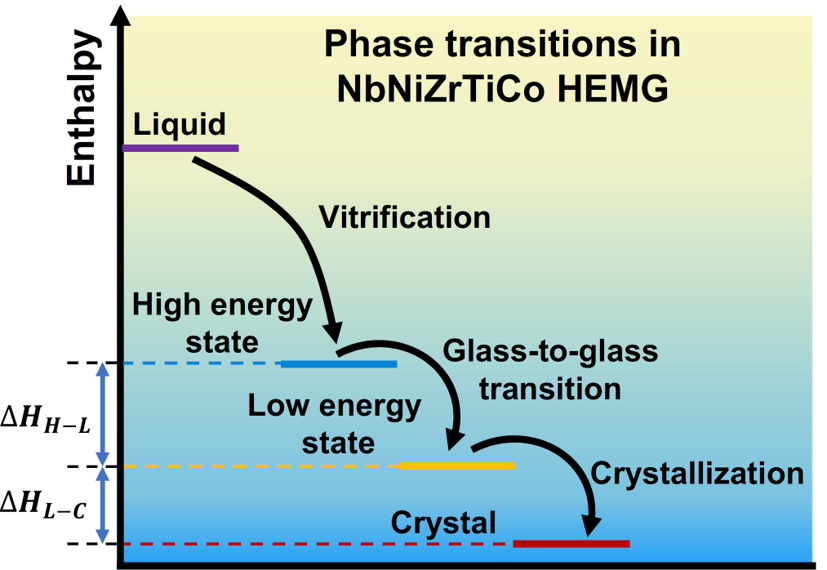High entropy: another dimension for glass states exploration and glassy properties tuning - Dr. Charles Zeng
APRIL 26, 2022
New study from a team of scientists co-led by Dr. Qiaoshi Zeng from Center for High Pressure Science and Technology Advance Research reported a high-entropy-induced glass-to-glass transition in the NbNiZrTiCo high-entropy metallic glass. This glass-to-glass transition leads to a significant improvement of the modulus, hardness, and thermal stability. Their findings demonstrate that high configurational entropy could be a new dimension for tuning the glass states and properties in multi-component amorphous alloys. This work has recently been published in Nature Communications.
In materials science, it is well known that structures dictate properties. Glasses are no exception to this relationship. Intense research efforts have been devoted to tuning the properties of metallic glasses by various methods, including thermal aging/rejuvenation, elastic/plastic deformation, applying high pressure/radiation, etc. However, effective tuning the structures of metallic glasses is still challenging, which hinders our fundamental understanding of glasses and also the capability for glass properties modification.
“In principle, there are almost infinite configurational local energy minima in the energy landscape of a multi-component metallic glass system, finding a transformation of metallic glass between different glass states (local energy minima) is of great interest to fundamental research of glasses”, explained Dr. Zeng, “Meanwhile, one can expect that via a glass-to-glass transition, we can have significantly different physicochemical properties for a given metallic glass, which can be switched and or regulated over a wide range by dramatic structural variations.
However, in practice, a glass-to-glass transition has seldom been observed in densely packed metallic glasses except in some special cases with pressure-induced electronic transitions. Recently, high-entropy metallic glasses with similar compositional characteristics as typical high-entropy alloys, i.e., consisting of multi-components with equal or near equal atomic ratios, have emerged as a novel class of metallic glasses. The high-entropy strategy opens up a new composition space for metallic glass exploration and also offers another parameter, entropy, for tuning metallic glasses.
The team of scientists developed a quinary NbNiZrTiCo high-entropy metallic glass and observed an obvious structural transition in the NbNiZrTiCo with a heat release during heating. Further analysis of synchrotron x-ray diffraction, transmission electron microscopy, and 3D atom probe measurements confirmed that this structure change is an irreversible structural glass-to-glass transition. In addition, a significant improvement in its physical properties was observed accompanying the transition.
“The high configurational entropy could create more metastable glassy states by stabilizing the system with more chemically disordered structures at high temperatures where the liquid is quenched,” explained Dr. Zeng. “When we heat the highly disordered high-entropy metallic glass to intermedium temperatures before it gets too much kinetic energy to crystallize, the system may gain energy to adjust its local structures to a lower-energy state and release its excess energy, i.e., a thermal-assisted glass-to-glass transition.”
In addition, they found similar glass-to-glass transitions in other quinary or senary high-entropy metallic glasses, and high excess configurational entropy (associated with the atomic size misfit) plays a key role, which demonstrates high entropy could be a new dimension for general glass states/properties tuning via polyamorphic glass-to-glass transitions.

Caption: Schematic illustration of distinct glass states and transitions between them in high-entropy multi-component metallic alloy systems.
近日,北京高压科学研究中心的曾桥石研究员团队与其合作者研究了NbNiZrTiCo五元高熵金属玻璃中高熵效应对玻璃结构、能量态、稳定性和物性的影响。研究发现,通过熔体快冷制备的NbNiZrTiCo高熵金属玻璃在加热过程中观察到了显著的不可逆玻璃-玻璃转变,且该转变伴随明显的放热现象。通过同步辐射X射线衍射、透射电子显微镜、以及三维原子探针的进一步分析,排除了晶化和调幅分解的可能,确认了玻璃-玻璃多形态转变的发生。此外,对样品进行的原位加热同步辐射X射线衍射实验结果表明,玻璃-玻璃转变前后的样品仍保持非晶态结构特征,但是其约化对分布函数中第一峰出现明显峰形变化,且第二峰发生劈裂,转变前后表现为两种在结构上显著不同的玻璃态。非晶结构的变化也引起了各种物理性能的较显著变化,从而为实际应用中实现金属玻璃材料性质的调控提供了新途径。该团队进一步发现高熵效应诱导的不同玻璃态及其转变现象在其他的多元高熵金属玻璃体系中也存在,说明高熵效应很可能是调控玻璃态和玻璃结构性质的新的有效参量。
